The Fool is the first card of the tarot’s Major Arcana, and represents someone starting off on a journey of learning about themselves and the world. That could be you! Learn how to read your cards and develop your mystic prowess with Autostraddle’s Tarot School. Or if that sounds like too much work, get a tarot reading right here!
After the first installment of The Fool’s Journey, a bunch of you wanted recommendations for tarot decks and/or books to get for Tarot School and for, like, life in general. So here’s a quick Tarot School extra with a few suggestions!
There are tarot decks for pretty much anything you might be into. You like medieval cats? Check this out. Japanese Anime? Ooh, lookit! Women’s Bodies Women’s Wisdom? Oh hey there’s a tarot deck for that! Literally weeks can be lost on the interwebs ogling all kinds of nerdy decks to match your passions. There are tarot decks for different spiritualities, decks for feminists and womanists, decks for animal lovers, decks for lovers of literature. My one piece of advice would be to choose something truly meaningful over a ‘novelty deck’ if this is your first tarot deck. Look for an aesthetic that speaks to you, and something you feel you can connect with on a deeper level.
If you’re already familiar with the cards, one fun way to find a great deck is to compare images of your favourite card. So for me, quite often I’ll look straight to the Queen of Swords, The Magician or the Ten of Cups in a potential new deck, to see how the creator has interpreted it.
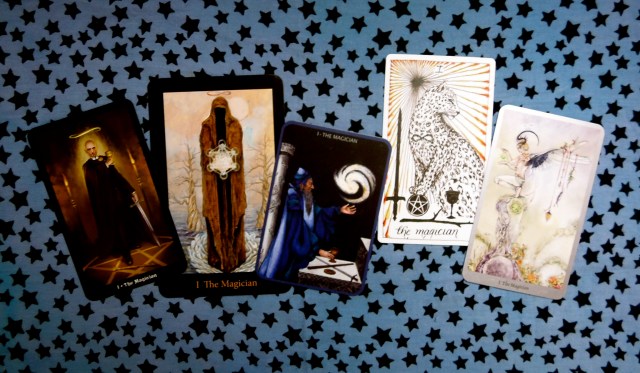
Think also about card size (dainty hands + big-ass cards = embarrassing shuffle situations) and also quality (cards printed on thin or cheap stock don’t last long and don’t feel anywhere near as nice to use).
A wee myth I keep hearing (and there are plenty of daft myths around the shoulds and shouldn’ts of tarot) – is that you should be gifted your first tarot deck. If this was the case then half of us would never have begun. Just get looking for one that speaks to you and treat yo’self.
Here are a few of my favourite decks to get you started, plus a couple of books and blogs. Please know that these reflect my own taste and the things I personally search for in tarot – there are so many more decks and books out there. It’s important you find something that works for you.
Also if you’ve got a favourite tarot deck of your own, please go ahead and share it in the comments!
The Rider Waite Smith Tarot
This is the most popular tarot deck in the western world and the one upon which most tarot books and learning resources are based. Created at the turn of the century by weird occultist Arthur Edward Waite, the forgotten hero of this deck is the artist, Pamela Colman Smith (who had a fascinating life.) She was given free rein to interpret Waite’s ideas however she chose, and her vivid paintings are mystical, theatrical and to my eyes utterly beautiful. Wherever I go with my tarot studies, I always end up back here with these old familiar cards.
The Wild Unknown Tarot by Kim Krans
Okay, so this is my number one favourite ever tarot deck. It only came out a year ago but as soon as I laid eyes on it, I was smitten. Kim Krans’ artwork is stark and beautiful, with intelligent use of shape and colour which bring layers of meaning to what look like simple, beautiful ink drawings. Also, this deck features no people! Which means that image-wise, you get to steer clear of the heteronormative whitewash that’s a real problem with so many tarot decks. Another plus is that the cards are a pleasure to hold (so many decks are printed on low-quality card stock or use nasty laminates – these are just gorgeous to use.) In the US you can get it direct from the artist, or if you’re in the UK (quick plug) I’ll be stocking it in a week or two!
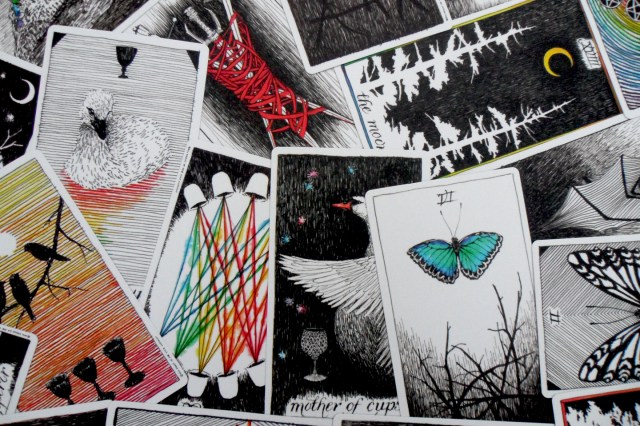
The Wildwood Tarot by John Matthews, Mark Ryan and Will Worthington
Pagan and nature-loving types will appreciate this deck, which works with the wheel of the year tradition and relies heavily on the seasons and the four elements, and comes with a detailed and beautifully written book explaining the archetypes and symbols used. One key idea that I love in the Wildwood Tarot is that it seeks to reconnect us with forgotten roots, to reestablish the human relationship with the natural world – with woods, seasons, animals, and our primal instincts.
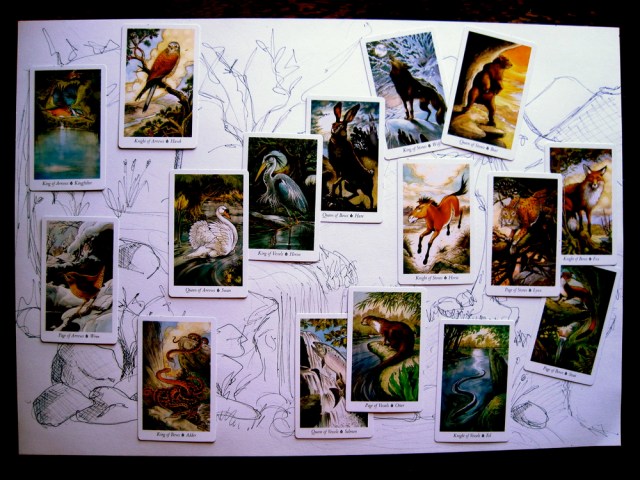
The Anna K Tarot by Anna Klaffinger
Austrian artist Anna Klaffinger created this deck because she wanted something free from heavy symbolism and which instead depicted ordinary people living ordinary lives (albeit in middle ages -type costumes.) This is a very ‘people-focused’ deck, and what I love most about it are the facial expressions, which really convey joy and pain, generosity and jealousy, hope and anger.
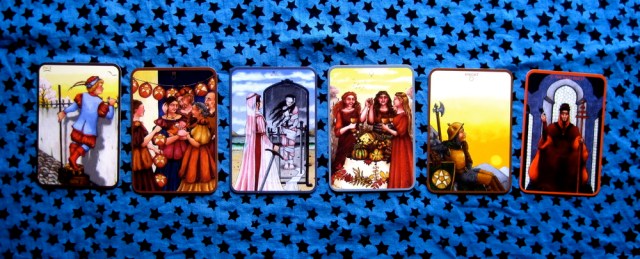
The Mary-el Tarot by Marie White
Marie White’s labour of love is a deep and complex deck, definitely not one for the tarot dabbler or the faint hearted. I’ve been using it since it was published two years ago and I still don’t feel confident using it to read for others, so much is there to learn here. But it’s so worth the investment. These oversized cards feature White’s oil paintings, which are richly coloured and heavily laden with mythological symbols and references.
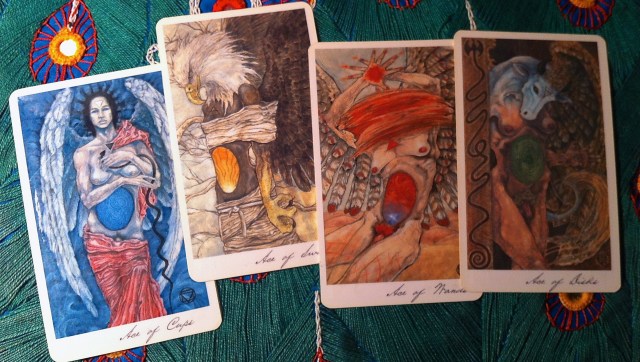
The Steampunk Tarot by Barbara Moore and Aly Fell
I bought this as a novelty deck, but it soon hooked me in with it’s ability to provide shockingly precise and clever readings and I often use it with my clients. These cards are filled with elegant Victorian ladies and gentlemen, punky pages (I so have a crush on the Page of Cups), wacky inventions and candlelit liaisons. It also comes with a proper, detailed book which is useful for beginners, but also a great read for more experienced readers.
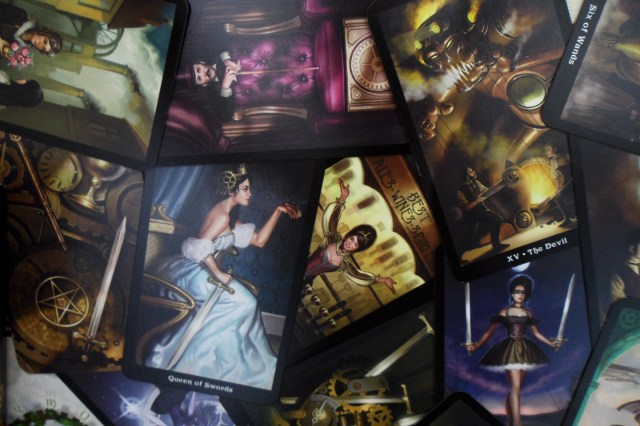
The Collective Tarot
It’s a real tease to include this as The Collective Tarot is no longer available to buy and it looks like it won’t be printed again. Noooo! But here’s a peek into how radical tarot can be. DIY artwork, a community of queer activist types including plenty of characters who are differently-abled, racially mixed, gender nonconforming, queer activist types, and reinvention of the four suits (e.g. cups become bottles) made this a tarot deck that speaks to people who want to politicise their tarot and use cards that reflect their own queer communities.
(BTW I totally missed the boat with this deck, so if any of you readers own a copy and for some reason are ready to part ways, help a sister out and hook me up!)
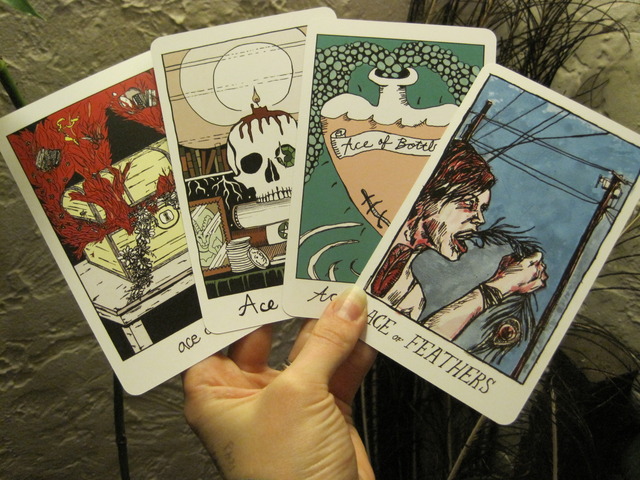
The Tarot of the Silicon Dawn by Egypt Urnash
A bunch of you mentioned this after the first Tarot School column – I don’t have a copy but following up on your recommendations it looks like I’m gonna have to invest! Created by a trans* future-fantasy artist Egypt Urnash, this is a weird and wonderful ‘kinky alien’ deck filled with sci fi references and computer geekery. You can read more about the deck plus an amazing interview with Urnash on Translabyrinth, by Morgan M.
Tarot Books and Blogs
Both of these books are great places to start getting your head around the ‘traditional’ card meanings (although I aim in Tarot School to help you depart from these and develop your own ideas over time.) As are most tarot books, they’re based on the Rider Waite Smith cards.
The ubiquitous guide for tarot beginners is Joan Bunning’s Learning the Tarot. Taking you one by one through each of the 78 cards and introducing you to a couple of common spreads (card reading layouts). You can buy the book (recommended!) or take advantage of Bunning’s generosity, as she has made the entire contents of the book available online for free here.
The book I loved when first learning tarot (and which I still turn to today) is Rachel Pollack’s Seventy Eight Degrees of Wisdom – another cult classic. I love Pollack’s deep (but not alienating) explorations of the cards, their symbols, their traditions.
There are also thousands of brilliant tarot blogs out there, each of which will give you the author’s personal take on the card meanings and an insight into different ways of reading them. You can find a list of my favourites on my own blog here. And if you already have a tarot blog of your own, link us up in the comments!







